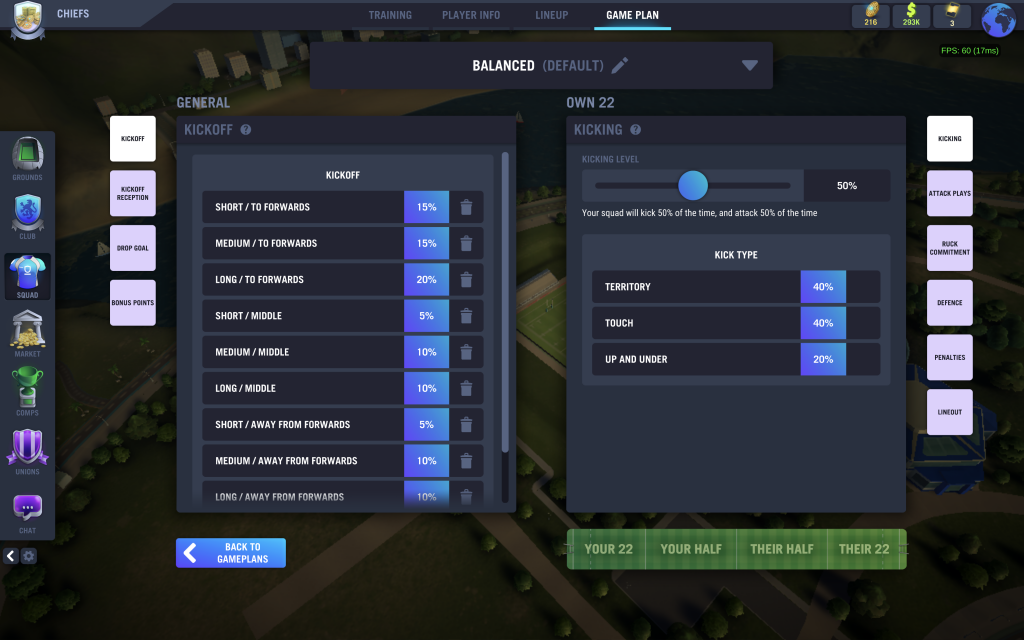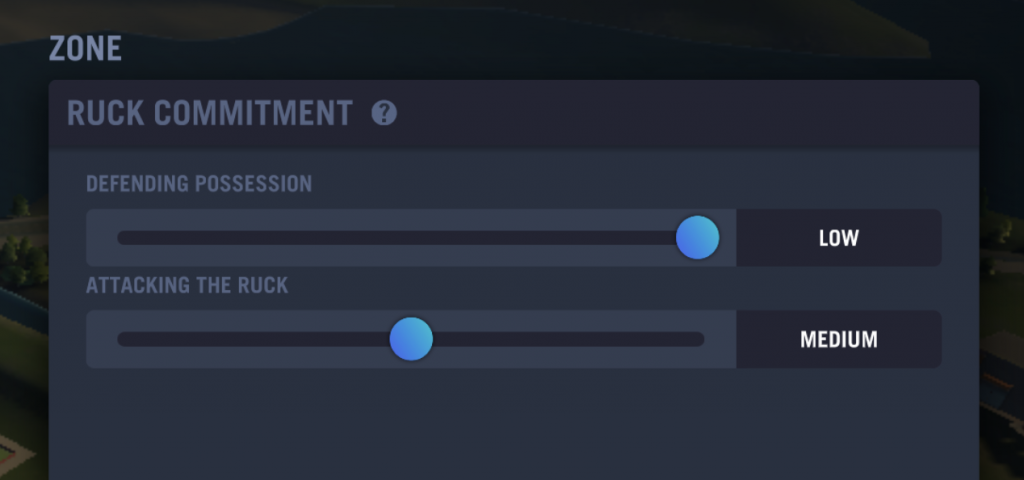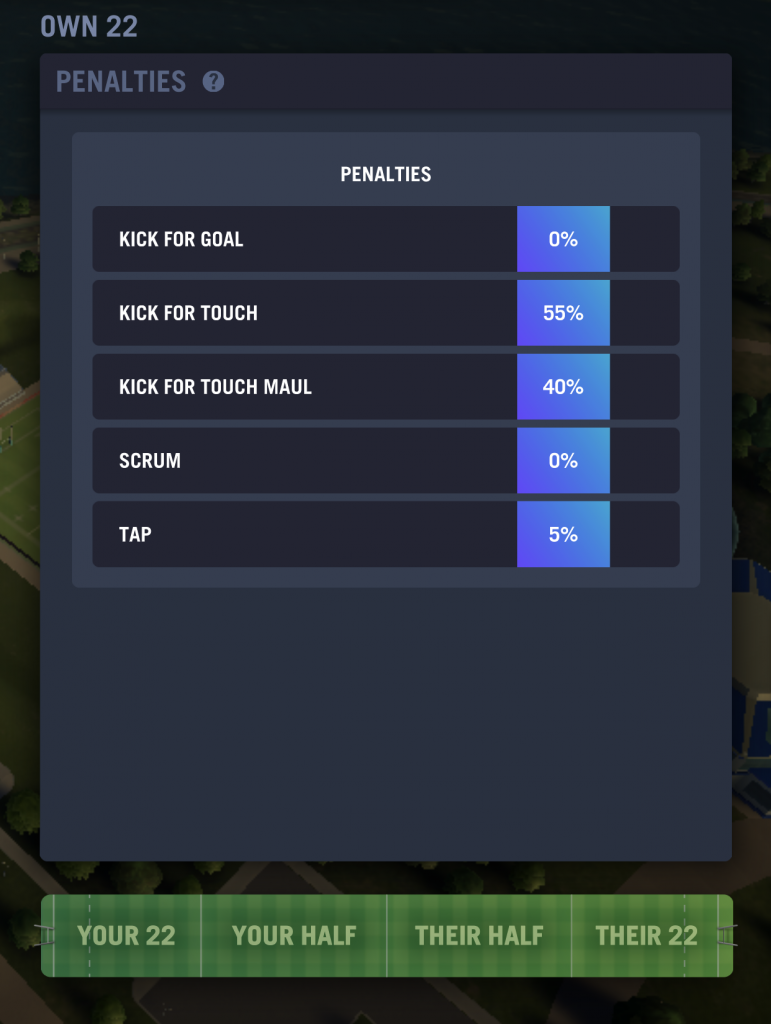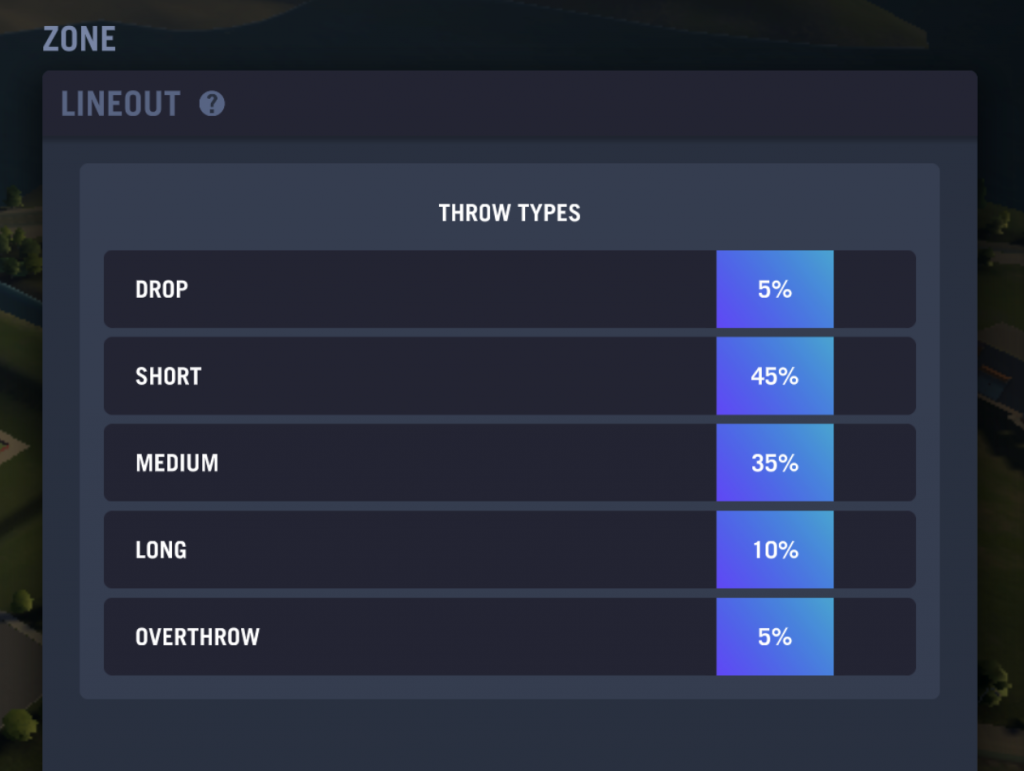Back again with part two of the examination of how tactics will work in the new game. In Part 1 we went through General Tactics and also had a look at how Attack Patterns operate within Zonal Tactics. This post will round out the other Zonal Tactics that the manager employs when setting up a game plan.
There are a number of options in addition to Attack Patterns that make up zonal tactics. We will explore each in turn and explain briefly what they are and how they affect how your team will play.

Kicking
The manager will set up for each zone how often they the team is likely to kick when they have possession in that zone. This is done by setting a percentage for kicking. When the team has the ball the match engine will determine whether the team is going to kick the ball or run an attack play, and it does this by looking at the Kick %. If the game determines the team will not kick then it looks at the attack pattern and chooses an attack play from there. There are other factors that affect the kick % the manager has set, such as the pressure the attacking team is under (the more pressure the attacking side is under, the more likely it is that they will kick to relieve that pressure), as well as if they are going all out to get a bonus point through scoring tries (if they are still seeking tries, then this will impact the chance of kicking, especially when they get into the opposition half).
The manager must also set which type of kick to use. There are three options here – Kick for Territory, Kick for Touch and Up & Under kick. The manager assigns a percentage chance for each kick type per zone. When the game determines that the attacking team will kick the ball it then looks at the percentages the manager has set for the type of kick and from that works out what kick type is chosen.

Ruck Commitment
For each zone the manager chooses a ruck commitment level for two situations – when they are defending their own ball in the ruck (i.e. when they are the attacking side with the ball); and when they are attacking the opposition ruck (i.e. when they are the defending side). Each can be set at one of three levels – Low, Medium or High.
A low ruck commitment means the team is trying to commit as few players as necessary to the ruck. This will allow more forwards to stay out of the ruck, thus making them available to attack if their team wins the ball, or having more of them out in the defensive line if they lose the ball. The downside is that the team won’t be so effective at winning their own ball or putting pressure on the opposition and potentially stealing the ball. A low commitment is useful when you believe your team’s forwards are going to be much stronger in the ruck, and so committing fewer players to the ruck won’t materially damage your ability to retain or win ball, but will give you more forwards to attack or defend with when the ball is out.
A high ruck commitment is useful when you think your forwards may be outclassed in the ruck, so adding bodies there will increase the chances of winning or stealing the ball. The downside is obviously that you have less forwards available to attack or defend with once the ruck is over. Another situation where high ruck commitment may be valuable is when you are in the opposition 22 and want to attack any rucks they may have in order to try and steal the ball – stolen ball here can be very dangerous. The other side of that coin is that sometimes a manager may want to have high ruck commitment when in their own 22 , to try and stop the opposition from stealing the ball.
Medium Ruck commitment does what it says on the tin. It takes the middle ground between low and high, and can be useful if you don’t want to take the plunge of going low and high. Medium ruck commitment is the standard ruck commitment setting.

Defence
For each zone the manager can pick one of three defence types: Man on Man, Drift or Rush. Each defence type has its strengths and weaknesses and, like most tactical aspects, there is not going to be a right or wrong defence. Which is best will depend on the two teams playing and their strengths and weaknesses. We are going to go into defence in more depth in a later blog post, so for now we will just give a brief description of what the three defence types mean.
- Drift Defence – The defensive line shifts as the ball moves out towards the other team’s wing, pushing the opposition towards the side of the field, allowing the sideline to work as an extra defender.
- Rush – The defensive line presses up quickly trying to limit the amount of time the opposition has with the ball before contact is made, and so limit the ability of the opposition to get the ball past midfield. When it works, the rush defence can really put the opposition under pressure, but it does have its dangers if the defence line does not work in unison properly.
- Man on Man – Each player in the defensive line is responsible for guarding one particular member of the opposition. This defence is a middle ground between Drift and Rush defences, and can be good when your team has a defensive edge, especially in the backs.

Penalties
For each zone the manager must determine what the team does if it wins a penalty in that zone. The first tactic the manager must set is their kick for goal % – this is what the minimum chance of a successful goal kick must be for the team to try a shot on goal. When the team has a penalty the game will determine the success chance of the designated goal kicker making the kick. This will be based upon the kicker’s kicking skill, their coordination, their composure, the distance and angle to the goal, and the weather conditions. If the chance of success is equal or greater than the Kick for Goal percentage the manager has set for that zone, then the team will go for the kick. If it is lower then the team will not take the shot and do something else with the penalty.
What this other thing is depends on what the manager has set out in the game plan. The penalty options a manager has are: take a tap penalty, kick for touch, or take a scrum. The manager will assign a % for each, and the ME will use this to determine what the team do with the penalty.
As to what the best settings are, again it will depend. The Kick for goal percentage can be set at anything, and what a manager decides on will depend on how risk happy or adverse they are. As for the other penalty options, kicking for touch is often useful when you get a penalty in your own half, but in the opposition 22, taking a scrum if your scrum is good, or taking a tap may be useful. The match engine will also look at other factors that may change the percentages the manager has set, such as the pressure the attacking team is exerting (if you have the defence reeling then a tap and go can be more effective), the weather and so on.

Lineout
A manager gets to set a percentage in each zone for the types of lineout throw their team will employ. The manager sets a percentage for each type and the match engine will use these to determine which type of throw is made. There are five types of throw possible:
- Drop – This is a quick throw to the very front of the line where a prop is normally standing to catch it. It is more of a trick, or surprise type throw, and if successful can leave the defence scrambling to deal with it. However, it is risky (need a prop with good catching and coordination) and can often lead to the ball being lost, knocked forward and so on.
- Short – A throw near the front of the lineout to the number 4 lock. This is an easier throw from the hooker and so is often a safe type of throw to take. However, the attacking options off a short throw are not as good as a longer throw, so it is more safety first. It can be useful when you are in the opposition 22 and want to make sure you win the ball and set up a catch and maul, or when in your own 22 and don’t want to reduce the risk of your lineout ball being stolen, or you think your lineout capabilities suffer in comparison to your opposition.
- Medium Throw – A throw to the middle of the line to your number 5 lock. Second only to the short throw for ease for the hooker and gives good all round attacking options, from getting the ball out fast to forming a catch and maul. This and the short throw are the most common types of lineout throws in general.
- Long Throw – A throw to the back of the lineout. This is a harder throw for the hooker to make than a short or medium throw, and the target is one of the back-row forwards. A long throw creates very good attacking ball when won and so if it can be done successfully is a great option. You need a hooker with good throwing and coordination and back-row players who can jump and catch.
- Overthrow – Another trick type throw. The ball is thrown beyond the lineout into midfield. If it works it can be great, if it doesn’t you have given the ball to the opposition and your defence may well be in trouble.
The manager has one additional setting in lineouts. This is the ‘Form Maul’ percentage. This is the percentage chance that after a successful catch your forwards will form a maul and drive towards the opposition line. If the maul is not formed then the match engine will look to the attack pattern and run an attack play from there. A maul can only be formed if the throw was a short, medium or long throw. Forming a maul from the lineout can be an effective tactic, especially when you have a pack that is good at mauling. In addition, a maul formed from a lineout gives the attacking team a slight bonus in the resulting maul battle, as they have the impetus.
Well that is it for Game Plans for the moment. We hope that you have a better idea of how the tactical options have been enriched and developed for the game. As a manager, you now have much greater control over how your team plays, and can tailor your tactics more easily to play to your strengths and the opposition’s weaknesses. Of course if you just want to play some rugby, then you can choose from our pre-made game plans.

Out now on Android, iOS, and Steam!

